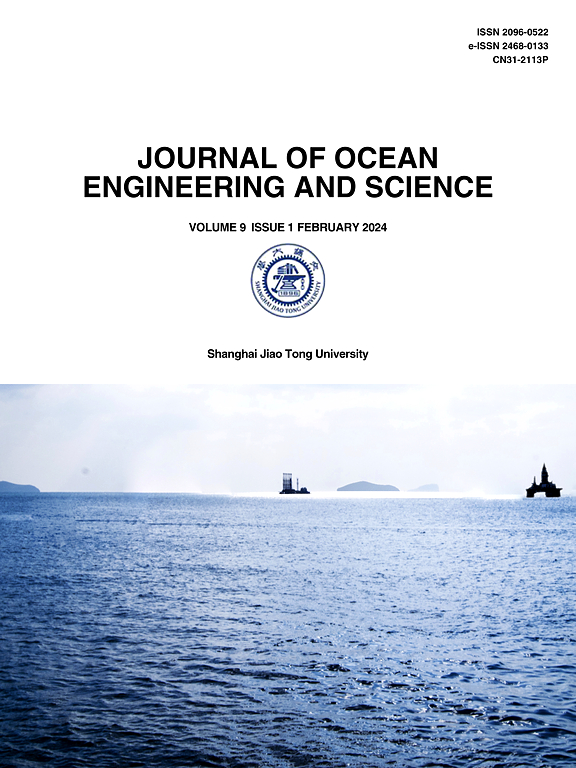Numerical study of a fish swimming in hydrokinetic turbine wake
IF 11.8
1区 工程技术
Q1 ENGINEERING, MARINE
引用次数: 0
Abstract
The environmental effects of hydrokinetic turbines are still under investigation, reflecting the emerging status of this technology. This study investigates the interaction between hydrokinetic rotor wakes and fish swimming, revealing insights into fish biomechanics in complex flows and assessing the environmental implications of marine energy solutions. We conducted numerical simulations with the URANS approach and turbulence closure model to predict three-dimensional turbulent flow in the OpenFOAM software. The hydrokinetic rotor wake was simulated employing the actuator line method, providing a computationally efficient alternative to full geometry simulations. For accurate replication of the motion of a fish-like tuna (Thunnus atlanticus), dynamic adaptive mesh discretization was employed. The results offer a comparative analysis of fish swimming performance within the wake rotor, particularly when immersed in the tip blade vortex, contrasted with scenarios where fish swim in undisturbed flow conditions. The analysis encompasses three-dimensional wake structures, force generation, efficiency, and equilibrium states (balancing drag and thrust) across varying Swimming numbers (). Key findings include the enhanced attachment of the leading-edge vortex due to the caudal fin’s interaction with the tip blade vortex, resulting in improved auto-propulsive force production; a reduced tail stride frequency observed in fish swimming downstream of the rotor to achieve longitudinal force balance compared to unperturbed flow; and transverse hydrodynamic forces pushing fish radially away from the wake’s influence zone, potentially mitigating the risk of collision with turbine blades.

水动力涡轮机尾流中鱼类游动的数值研究
水动力涡轮机的环境影响仍在调查中,反映了这项技术的新兴地位。本研究探讨了流体动力转子尾迹与鱼类游泳之间的相互作用,揭示了复杂流动中鱼类生物力学的见解,并评估了海洋能源解决方案对环境的影响。我们利用URANS方法和k−ω−SST湍流闭合模型在OpenFOAM软件中进行了数值模拟,以预测三维湍流。采用致动器线法模拟了水动力旋翼尾迹,为全几何模拟提供了一种计算效率高的替代方法。采用动态自适应网格离散方法,精确地模拟了大西洋金枪鱼的运动。结果提供了鱼在尾流旋翼内的游泳性能的对比分析,特别是当鱼浸入叶顶涡时,与鱼在不受干扰的流动条件下游泳的情况。分析包括三维尾流结构,力产生,效率和平衡状态(平衡阻力和推力)在不同的游泳数(Sw)。主要发现包括尾鳍与叶尖涡的相互作用增强了前缘涡的附着性,从而提高了自推进力的产生;与无扰动流相比,在转子下游游动的鱼中观察到尾部跨步频率降低,以实现纵向力平衡;横向的水动力将鱼从尾流的影响区推向径向,潜在地降低了与涡轮叶片碰撞的风险。
本文章由计算机程序翻译,如有差异,请以英文原文为准。
求助全文
约1分钟内获得全文
求助全文
来源期刊

Journal of Ocean Engineering and Science
Multiple-
CiteScore
11.50
自引率
19.70%
发文量
224
审稿时长
29 days
期刊介绍:
The Journal of Ocean Engineering and Science (JOES) serves as a platform for disseminating original research and advancements in the realm of ocean engineering and science.
JOES encourages the submission of papers covering various aspects of ocean engineering and science.
 求助内容:
求助内容: 应助结果提醒方式:
应助结果提醒方式:


